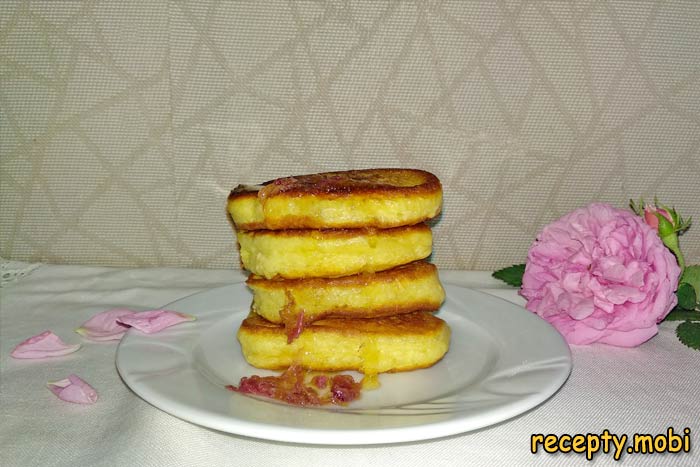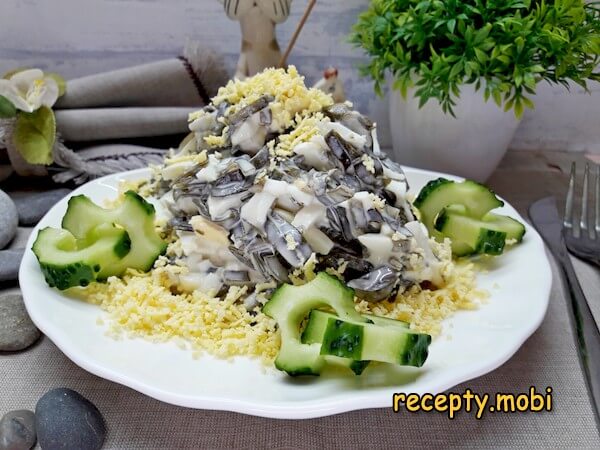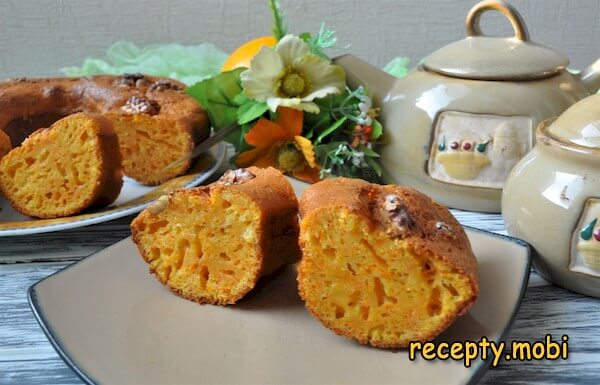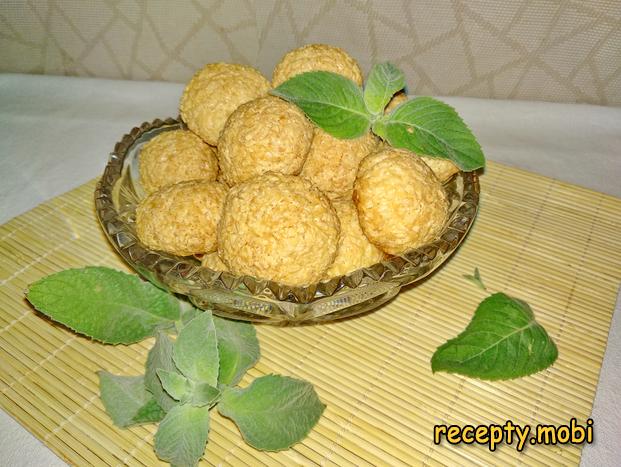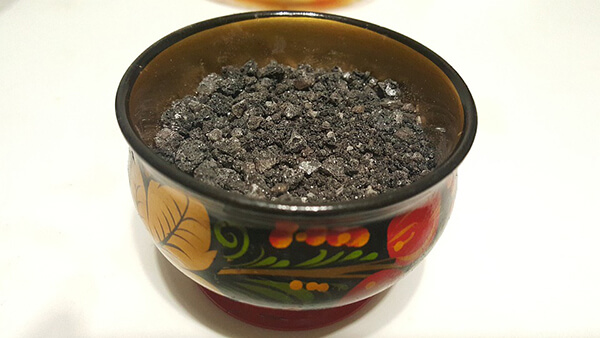
Thursday salt
- Thursday salt is a unique product made through a special process from regular salt. It was used in Russian Orthodox culture and was traditionally prepared once a year during Holy Week on the night of Clean Thursday or on the morning of Clean Thursday. This is where the name 'Thursday salt' comes from. It is also known as 'Black salt' due to the dark color it acquires when exposed to high temperatures.
- In the past, Thursday salt was blessed in the church and used during the Easter feast. Colored eggs during Easter were exclusively eaten with this salt. A large quantity was prepared, and any leftovers were used as regular salt until the next Clean Thursday. It was stored away from prying eyes.
- There was a belief that it would protect the household from the evil eye and illness. For this reason, a pinch of this salt was added to the water when bathing infants.
- To ensure that there is always abundance in the home, the salt shaker with Black salt should always be placed on the dining table. The protective properties were attributed only to the salt that had been blessed in church.
- How to Store
Thursday salt is a product prepared in a special way from ordinary salt. It was used in Russian Orthodox culture, and was prepared only once a year - on a passionate week on the night of a clean Thursday, day or in the morning of a clean Thursday. Hence the name "Thursday salt". The second name "black salt" appeared due to the dark color, which acquires salt under the influence of high temperature.
Thursday salt is a unique product made through a special process from regular salt. It was used in Russian Orthodox culture and was traditionally prepared once a year during Holy Week on the night of Clean Thursday or on the morning of Clean Thursday. This is where the name 'Thursday salt' comes from. It is also known as 'Black salt' due to the dark color it acquires when exposed to high temperatures.
Previously, the Thursday salt was consecrated in the temple and used at Easter meal. Painted eggs in Easter ate exclusively with her. They cooked a lot of it, and then the remaining one was used as ordinary salt until the next clean Thursday. They stored away from prying eyes.
There was a belief that she would protect the households from the evil eye and illness. For the same purpose, a pinch of such salt was added to the water when bathing babies.
In order for the house there is always prosperity, a solo with black salt should always stand on the dining table. The properties of the amulet were attributed only to salt consecrated in the church.
The patient was given to drink water with such salt. A pinch of Thursday salt was slowly stirred in a glass of water, saying:
“How the salt is burned with fire, so that the body (human name) is filled with health. Amen!"
Everyone decides how to relate to belief, but they did not talk about the benefits of black salt in those days, since its chemical composition was studied later.
In the past, Thursday salt was blessed in the church and used during the Easter feast. Colored eggs during Easter were exclusively eaten with this salt. A large quantity was prepared, and any leftovers were used as regular salt until the next Clean Thursday. It was stored away from prying eyes.
In the process of firing salt, its chemical composition changes, and it becomes more useful for humans than ordinary white. The content of heavy metals is reduced ten times, chlorine is practically leaving. It is chlorine after salted food that causes a thirst that provokes the formation of edema.
The ash when cooking ash enriches the salt with useful trace elements:
- potassium;
- iodine;
- zinc;
- calcium;
- selenium;
- copper and others.
Burnt salt contains carbon, which helps eliminate waste and toxins from the body.
After preparation, you will have a new product with different properties.
There was a belief that it would protect the household from the evil eye and illness. For this reason, a pinch of this salt was added to the water when bathing infants.
People who have tried Thursday salt have mixed feelings about its flavor. Some enjoy it for its aromatic spices, while others note a distinct sulfur-like taste. As they say, there is no accounting for taste. Additionally, it can be prepared in various ways with different proportions of salt and additives.
However, making this salt is worthwhile not just for tradition but for its beneficial qualities.
To ensure that there is always abundance in the home, the salt shaker with Black salt should always be placed on the dining table. The protective properties were attributed only to the salt that had been blessed in church.
The recipes for making Thursday salt have been adapted for modern kitchens, allowing you to create it anywhere. You can adjust the ingredient ratios depending on how salty you want the final product. Keep in mind to turn on the ventilation or open a window, as smoke will be released.
Do not use iodized salt or salt with other additives.
Sick individuals were given water mixed with this salt. A pinch of Thursday salt was slowly stirred into a glass of water while saying the following:
Ingredients:
- coarse salt – 1 kg;
- Leaves of any dried spicy herbs - a large handful;
- rye bread – 1 kg.
Preparation:
- Take a handful of dried mint, lemon balm, oregano, or any other aromatic herbs. Chop them finely and mix with 1 kg of coarse salt.
- Add about 1 kg of crushed rye bread. Stale bread can be grated.
- Mix everything well and pour the layer on a baking sheet. Put a baking sheet in the oven, preheated to 250 degrees and periodically mix everything. After some time, the salt will be compacted-it will need to be broken as possible so that it can be mixed.
- After about 40 minutes, the bread will begin to darken, char, and smoke. At this point, turn off the oven, stir everything again, and leave it in the oven to cool. The bread should darken and just start to smoke; otherwise, if it is burnt too much, it will taste bitter.
- Once cooled, pass it through a meat grinder or grind it using another method.
Based on kvass
Not everyone has access to kvass mash, which is derived from fermenting wort. However, you can easily substitute it with soaked rye bread. For every kilogram of salt, use about three loaves of bread or even more.
Ingredients:
- coarse salt – 1 kg;
- kvass mash – 1 kg or rye bread – 3 loaves;
- spices to taste.
Preparation:
- If you are using bread, soak it in water and soften it until it forms a uniform mass.
- Add the salt and any spices you desire to the soaked bread or kvass mash. Mix well.
- Spread the mixture in an even layer on a baking sheet and place it in the oven at 250 °C.
- After about 10 minutes, break the dried layer into pieces and return it to the oven. Stir occasionally.
- In about 30 to 40 minutes, the mixture will start to burn, and you will notice smoke from the burnt bread. Stir it and let it cool.
- Once cooled, thoroughly grind the mixture.
With Oats or Flour
Ingredients:
- coarse salt – 200 grams;
- oats or rye flour – 200 grams;
- any spices – 2 teaspoons;
- water – as needed.
Preparation:
- Combine the oats (or flour) with the spices.
- Gradually pour in cold water while stirring continuously until you achieve a stiff dough consistency.
- Add the salt to the dough and mix well.
- Divide the dough into pieces the size of medium potatoes and wrap each one in three layers of foil.
- Bake the dumplings until the dough turns black. You can do this in a hot oven, in a Russian stove, or over hot coals like you would with potatoes. This will take about 40 minutes to an hour. Make sure to keep a large fire going, as the coals cool quickly. Add unburnt wood from the edges of the fire to maintain the temperature.
- After about 40 to 60 minutes, when the mixture has baked and turned black, leave it wrapped in foil (in the oven, stove, or fire) until it cools.
- Once cooled, unwrap the Thursday salt from the foil. Grind it in a mortar or using another method. Sift it well.
The sifted powder can be added to bathwater or used for washing. You can also create masks for your hands and face.
How Thursday Salt Was Made in Ancient Times
Traditionally, Thursday salt was prepared in a Russian stove using dry birch wood. In such conditions, temperatures can reach 800 degrees or more. There were various recipes, but one of the simplest was as follows.
To one kilogram of coarse salt, add two slices of soaked rye bread and a handful of chopped medicinal herbs. The herbs can vary, such as oregano, St. John's wort, cumin, or even wormwood. This mixture is placed in a cast iron pot over hot coals. It is kept there for several hours until the salt darkens. Afterward, it is cooled and ground. During the preparation, recite the 'Our Father' or a special prayer three times.
‘Pure Thursday, protect and have mercy from worms and all evil.’
How to Store
Traditionally, the prepared Thursday salt was stored in linen bags in a dry, secluded place to keep it away from prying eyes.
This product stores well in glass jars, which help preserve the aroma of the herbs for a longer time.
Transfer the prepared salt into a glass container. Cover it with thick paper and store it in a dark place.

